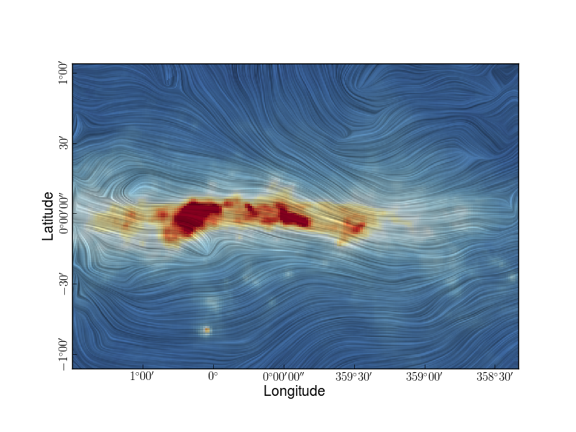PILOT maps the magnetic field at the core of the Milky Way
The magnetic field in the dense twisted loop of gas and dust surrounding the black hole at the centre of our Galaxy has been revealed in a new image from the PILOT stratospheric balloon experiment. This is the first time that this unique region of the sky has been observed using the polarisation of dust emission at far-infrared wavelengths.

The PILOT balloon experiment is designed to observe in the Far-Infrared at 240 microns, a spectral domain where radiation from the sky is completely blocked by the earth atmosphere. To reach this goal, the 1 ton gondola hosting the instrument developed by the CNRS, the CEA and external partners is brought into the stratosphere at 40 km by the largest Helium stratospheric balloons operated by the CNES. In the Far-Infrared spectral domain, the sky emission is dominated by thermal radiation from tiny dust particles which are intimately mixed with interstellar gas. The PILOT experiment is specifically designed to measure the polarization of this radiation which is produced because dust particles are elongated and are partially aligned with the magnetic field which pervades the interstellar medium. This type of measurements allows scientists to constrain the geometry of the magnetic field, which is shaping the filamentary structures in space and is thought to play a major role in star formation. They also bring a unique attack angle to better understand dust composition and size distribution, as well as the physical processes responsible for the alignment of dust grains over large volumes of interstellar space.
During the second flight of the PILOT instrument, which took place from Alice-Springs, Australia, the observations concentrated on regions of the sky only visible from the Southern hemisphere. Among these, the center of our Galaxy is an important target. The central molecular zone which surrounds the center of our Galaxy is the densest and the brightest region of the interstellar medium in the whole Galaxy. This region hosts a very dense twisted torus of gas and dust which, as seen from earth, ressembles the infinity symbol.
This region is very bright in the infrared, due to the large accumulation of dust and gas along the line of sight, which is favorable for astronomical measurements. The polarization direction observed with PILOT is consistent with that seen at a different frequency with the Planck satellite, and with a magnetic field essentially aligned with the plane of our galaxy. However, the polarization of the emitted light in this region of the sky is particularly low, probably because the magnetic field is extremely tangled along the line of sight, which contributes to cancel out the emergent polarization. The fact that we are able to successfully measure polarization in such a region indicates that the instrument is working correctly. In particular, it shows that the calibration scheme used allows to control the relative response of our detectors to a very good accuracy. This particular observations lasted 30 mn and was part of a successful 33 hours flight.
It is the first time that this unique region of the sky is observed in polarization in the Far-Infrared, near the peak of dust emission, with such a good angular resolution (2 arc minutes). The measurements, upon detailed analysis, will provide the best view of the magnetic field structure in the central molecular zone. This may help understand the extremely high star formation rate of this region. The measurements will also be important to constrain the average galactic spectral energy distribution of polarized light up to the far infrared.
IRAP Contacts
- Jean-Philippe Bernard, IRAP (CNRS/Université Paul Sabatier-Toulouse III), Jean-Philippe.Bernard@irap.omp.eu, 05 61 55 75 38
- Anna Mangilli, IRAP (CNRS/Université Paul Sabatier-Toulouse III), Anna.Mangilli@irap.omp.eu, 07 87 61 77 64






